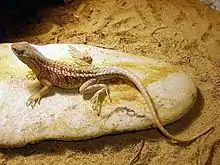Chalarodon
Chalarodon is a genus of Malagasy terrestrial iguanian lizard. It was considered a monotypic genus, until in 2015 a second species, Chalarodon steinkampi, was recognised based on morphology and DNA sequence data.[1] The common names of this genus include Chalarodon or Dangalia lizard.
| Chalarodon | |
|---|---|
 | |
| Chalarodon madagascariensis | |
| Scientific classification | |
| Kingdom: | Animalia |
| Phylum: | Chordata |
| Class: | Reptilia |
| Order: | Squamata |
| Suborder: | Iguania |
| Family: | Opluridae |
| Genus: | Chalarodon Peters, 1854 |
Its Malagasy relatives are the iguanians of the genus Oplurus.
Species
Two species of Chalarodon exist:
| Image | Scientific name | Distribution |
|---|---|---|
 | Chalarodon madagascariensis Peters, 1854 | Western, southern, and south eastern Madagascar |
| Chalarodon steinkampi Miralles, Glaw, Ratsoavina & Vences, 2015 | Eastern Madagascar | |
Habitat
Members of this genus inhabit semi-arid to arid regions and almost entirely open, or very sparsely vegetated habitats with sandy soil in southern, western, and south eastern Madagascar.[2]
Nutrition
The Madagascar sand lizards are insectivores. In addition to insects, sometimes plants are ingested, particularly in the form of leaves and roots.
Reproduction
During the mating season, males defend territories with threat displays and combat.[2] Copulation is very brief, and females lay pairs of eggs between December and March.[2]
References
- Miralles, Aurelien; Glaw, Frank; Ratsoavina, Fanomezana; Vences, Miguel (2015). "A likely microendemic new species of terrestrial iguana, genus Chalarodon, from Madagascar". Zootaxa. 3946 (2): 201–20. doi:10.11646/zootaxa.3946.2.3. PMID 25947685.
- Glaw, Frank; Vences, Miguel (2007). A Field Guide to the Amphibians and Reptiles of Madagascar (3rd ed.). Köln: Vences & Glaw Verlags. ISBN 978-3-929449-03-7.